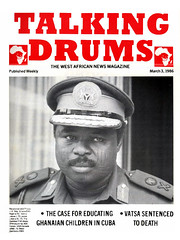Music And Arts Scene
African Records Review by Kwabena Asamoah
ISMAEL LO: Xalat (CEL 8717)
Xalat' "Tali Be' 'Lote Lo'l'Xamul' 'Mariama' 'Fa Diallo.
Graduating from the famous Super Diamono de Dakar (Senegal) as the lead singer it is to be expected that Ismael Lo would one day turn into a solo artist. Xalat is the album which turned his dream into reality. The response of his com- patriots was overwhelming, which has re- (DWAPS 2252) echoed in France and other parts of Francophone Africa.Taking advantage of the rich culture of Senegambia, Ismael Lo (like Youssou N'Dour) has mustered courage to exhibit some of the beauty spots of Senegambian music. The opening 'Xalat' might be sufficient to define some of the salient points in his music - jazzy guitar chords handled by Vieux Faye, strong percus- sion, good rhythm guitar and vocal support.
Tali Be' might sound a mere harmonica slowie but therein lies Ismael Lo's emotional approach to his music. He uses his acoustic guitar and harmonica to colour this track which is essentially a listening piece. As if to set the clock back a little Lote Lo' swings into a Latin American tempo which had dominated the entire Francophone Africa for years before Youssou N'Dour and others came in with their authentic African sounds. Of course, Sele Thiam's sax solo paints a rather different picture of the atmosphere before Vieux Faye comes in with his beautiful guitar solo accompanied by key- boards improvisations by Manou Lima.
The arrangements in Xamul Dara' might sound a bit rough-edged but the frantic percussion smacks of a promising mbalax style for the future if not now. It even sounds like one of Toure Kunda's songs but Ismael Lo certainly has his own direction which is already reckoned to be defined in his latest Xlif sub-titled 'mbalax new look'. 'Mariama' is not entirely different from 'Xamul Dara' but the concluding Fa Diallo' has some rootsy nostalgia which characterises some African songs. There is no immediate threat to Youssou N'Dour in terms of punch and appeal but Ismael Lo is cer- tainly a man to watch from the rich cultural heritage of Senegambia.
EBENEZER OBEY: Gbeja Mi Eledumare
'Gbeja Mi Eledumare' 'Olorun Oba Tiwa Dowo Re' 'Aiye Ju Daniel Si Iho Kinniun'/'Olorun Oba Ni Baba' 'Kosi Ohun To Soro Se F'Olorun' 'Werepe Ma So Mo'Eni To Gbero Ika'
Recorded in 1979 and released just before last Christmas, this album will pre- dictably be welcomed by juju music purists who like me would feel that the style here sounds more authentic than most recent releases. Ebenezer Obey's position at the top of the juju music ladder is still intact and Gbeja Mi Eledumare is only a confirmation of this fact.The gentle beginning of the A-side is meant only to give listeners enough time to adjust to Obey's beautiful music before it graduates into even more hypnotic music fusion of hi-life, traditional, Afro- beat and all that jazz. Real guitar solos are by my experience rare but Obey releases a compelling break of solos before intro- ducing Aiye Ju Daniel Si Iho Kinniun! Although the interval between the third and the fourth one could have relapsed into the usual juju monotony, the clever use of percussion, guitars and talking drums spare listeners this loose end.
Unlike the A-side, 'Olorun Oba Ni Baba' launches into an enticing mood right from the beginning of the B-side. One is immediately convinced of the authenticity of Obey's music with its measured pace, tempo and instrumental divisions. Of course, his own beautiful voice is re-echoed by the chorus while the talking drums toe the line. The let-up period in 'Kosi Ohun To Soro Se F'Olorun' is followed by a clever guitar solo in the vein of E.T. Mensah's oldie Nkebo Baaya! What I believe will con vince a lot of listeners is how Obey and his group handles the music from this stage till the end. Some talk of Sunny Ade but I cannot hide my preference for Ebenezer Obey. You might disagree but grab a copy of this record and be objective.
AFRO HOT CHART
1. BOYA YE M'Bilia Bel (STERNS) Zaire2. DIVORCE Lubaki Geant (ASWE) Congo
3. MARIO Franco (CHOC) Zaire
4. ASANTEMAN Pat Thomas (JAP) Ghana
5. SERVICE LIBRE Eyango Ndedi (DICK'S) Cameroon
6. AU COEUR DE PARIS Les Amazones (ENIMAS) Guinea
7. TORONTO BY NIGHT A.B. Crentsil (WAZURI) Ghana
8. BREAKTHROUGH Mandy (FAZE 2) Nigeria
9. 1x2=MABE Youlou Mabiala (APIA) Congo
10. ZULU JIVE VOL. 2 Various Artists (EARTHWORKS) Azania
11.GBEJA MI ELEDUMARE Ebenezer Obey (AFRODISIA) Nigeria
12. MALANGA Kanda Bongo Man (BM) Zaire
13. IZIBANI ZOMGQASHIYO Mahotella Queens (EARTHWORKS) South Africa
14. SAVIOUR Sunny Ade (SALPS) Nigeria
15. OBERIMA NKWAN YEDEKofi Asamoah (DOMINO) Ghana
Chart courtesy of AFROBOOM RECORDS,
1st Floor Wren Suite, 189 Stoke Newington High Street, London N16 (Mail order and distribution only.)
Record entries for 1986 Noma Award
The 1986 Noma Award for Publishing in Africa has attracted a record number of entries, and from a record number of coun- tries. For this year's competition 37 pub- lishers, from 22 African nations, have forwarded a total of 108 titles to the Award's administrators, The African Book Publishing Records.The Noma Award Managing Committee, under the Chairmanship of Professor Eldred Jones, is meeting in Freetown, Sierra Leone, in mid-May to select the 1986 prize winner. In selecting the winning title each year the Committee, or jury, is guided by reports from a large number of subject specialists to whom entries are sent for assessment.
Members of the Committee serve a three-year term, and the new members for the 1986-1988 period include: Professor J.F. Ade Ajayi, Department of History, University of Ibadan, Nigeria and Dr Abena Busia, Department of English, Rutgers State University, New Brunswick, USA.
